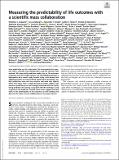Notice
This is not the latest version of this item. The latest version can be found at:https://dspace.mit.edu/handle/1721.1/135360.2
Measuring the predictability of life outcomes with a scientific mass collaboration
| dc.date.accessioned | 2021-10-27T20:23:08Z | |
| dc.date.available | 2021-10-27T20:23:08Z | |
| dc.date.issued | 2020 | |
| dc.identifier.uri | https://hdl.handle.net/1721.1/135360 | |
| dc.description.abstract | © This open access article is distributed under Creative Commons Attribution-NonCommercialNoDerivatives License 4.0 (CC BY-NC-ND). How predictable are life trajectories? We investigated this question with a scientific mass collaboration using the common task method; 160 teams built predictive models for six life outcomes using data from the Fragile Families and Child Wellbeing Study, a high-quality birth cohort study. Despite using a rich dataset and applying machine-learning methods optimized for prediction, the best predictions were not very accurate and were only slightly better than those from a simple benchmark model. Within each outcome, prediction error was strongly associated with the family being predicted and weakly associated with the technique used to generate the prediction. Overall, these results suggest practical limits to the predictability of life outcomes in some settings and illustrate the value of mass collaborations in the social sciences. | |
| dc.language.iso | en | |
| dc.publisher | Proceedings of the National Academy of Sciences | |
| dc.relation.isversionof | 10.1073/PNAS.1915006117 | |
| dc.rights | Creative Commons Attribution-NonCommercial-NoDerivs License | |
| dc.rights.uri | http://creativecommons.org/licenses/by-nc-nd/4.0/ | |
| dc.source | PNAS | |
| dc.title | Measuring the predictability of life outcomes with a scientific mass collaboration | |
| dc.type | Article | |
| dc.relation.journal | Proceedings of the National Academy of Sciences of the United States of America | |
| dc.eprint.version | Final published version | |
| dc.type.uri | http://purl.org/eprint/type/JournalArticle | |
| eprint.status | http://purl.org/eprint/status/PeerReviewed | |
| dc.date.updated | 2021-02-02T18:52:00Z | |
| dspace.orderedauthors | Salganik, MJ; Lundberg, I; Kindel, AT; Ahearn, CE; Al-Ghoneim, K; Almaatouq, A; Altschul, DM; Brand, JE; Carnegie, NB; Compton, RJ; Datta, D; Davidson, T; Filippova, A; Gilroy, C; Goode, BJ; Jahani, E; Kashyap, R; Kirchner, A; McKay, S; Morgan, AC; Pentland, A; Polimis, K; Raes, L; Rigobon, DE; Roberts, CV; Stanescu, DM; Suhara, Y; Usmani, A; Wang, EH; Adem, M; Alhajri, A; AlShebli, B; Amin, R; Amos, RB; Argyle, LP; Baer-Bositis, L; Büchi, M; Chung, B-R; Eggert, W; Faletto, G; Fan, Z; Freese, J; Gadgil, T; Gagné, J; Gao, Y; Halpern-Manners, A; Hashim, SP; Hausen, S; He, G; Higuera, K; Hogan, B; Horwitz, IM; Hummel, LM; Jain, N; Jin, K; Jurgens, D; Kaminski, P; Karapetyan, A; Kim, EH; Leizman, B; Liu, N; Möser, M; Mack, AE; Mahajan, M; Mandell, N; Marahrens, H; Mercado-Garcia, D; Mocz, V; Mueller-Gastell, K; Musse, A; Niu, Q; Nowak, W; Omidvar, H; Or, A; Ouyang, K; Pinto, KM; Porter, E; Porter, KE; Qian, C; Rauf, T; Sargsyan, A; Schaffner, T; Schnabel, L; Schonfeld, B; Sender, B; Tang, JD; Tsurkov, E; van Loon, A; Varol, O; Wang, X; Wang, Z; Wang, J; Wang, F; Weissman, S; Whitaker, K; Wolters, MK; Woon, WL; Wu, J; Wu, C; Yang, K; Yin, J; Zhao, B; Zhu, C; Brooks-Gunn, J; Engelhardt, BE; Hardt, M; Knox, D; Levy, K; Narayanan, A; Stewart, BM; Watts, DJ; McLanahan, S | |
| dspace.date.submission | 2021-02-02T18:52:02Z | |
| mit.journal.volume | 117 | |
| mit.journal.issue | 15 | |
| mit.license | PUBLISHER_CC | |
| mit.metadata.status | Authority Work and Publication Information Needed |
